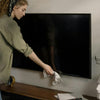Turn a Wall-Mounted TV Into a Second Monitor for Your Home Office

Turn a Wall-Mounted TV Into a Second Monitor for Your Home Office
Working from home used to mean making do with whatever equipment you had on hand. Today, the technology and design options are simply too amazing to settle for some haphazard home office.
Top of the upgrade list: Turn a wall-mounted TV into a second monitor for your home office. The increased digital real estate can be a huge boost to your comfort, efficiency and productivity. This guide shows you how to use your TV as a second monitor.
First step: Consider pixel density
Compared to monitors, televisions typically have lower pixel density and higher input lag, so small text can appear fuzzy and mouse movements may feel sluggish.
MantelMount Perspective
Consider a modern 4K TV between 40 and 43 inches with a “PC” or “Game” mode. These help address these issues by offering sharper images and lower latency.
Do you plan to sit at a desk?
If yes, pick a screen with an adjustable VESA-compatible mount, and mount it so the center is at eye-level. This reduces neck strain. Use a full-motion or tilt mount so you can angle the display downward for comfortable viewing.
Connecting the TV
Most computers include an HDMI port; otherwise, use a DisplayPort-to-HDMI adapter.
Aim for a viewing distance of about an arm’s length; a 40-inch 4K TV looks crisp at 2-3 feet.
Lighting matters, so avoid glare by placing the screen away from windows and use ambient lighting to reduce eye fatigue.
MantelMount Pro Tip
MantelMount TV mounts are designed for TVs 45-90 inches. Our customers appreciate that a 45-inch screen covers the mounting hardware, so consider that if you’re making a fresh purchase.
If you crave more clarity than your old TV can provide, consider investing in a purpose-built monitor. Monitors are designed for close-up work and often include ergonomic stands.
Experiment with different input methods
A simple HDMI cable will mirror your computer’s output with virtually zero latency, but you can also connect wirelessly through technologies like AirPlay or Chromecast if your devices support them.
Wireless connections reduce cable clutter and make it easier to reposition your workspace. Whatever method you choose, be sure to adjust the display settings on your computer.
Enable ‘game mode’
TVs are designed for movies, not spreadsheets, so enable “game mode” to reduce input lag and disable image processing features like motion smoothing that can cause text to appear blurry.
If needed, you can then tweak the resolution and scaling settings in your operating system to ensure text is easy-to-read from your work station.
Ergonomics
If using a wall-mounted TV as a second monitor, proper ergonomics is vital to your long-term comfort. We recommend:
- Position the center of the TV at or slightly below your eye-level when seated (to minimize neck strain).
- If the TV sits higher on the wall, invest in a tilting mount and angle the screen downward. Keep the top of the screen no higher than 15 degrees above your seated eye line.
- Pay attention to viewing distance. A 40 to 55-inch TV works best at around 5 to 8 feet away, whereas a 65-inch display may require 9 feet or more for the greatest clarity.
- Adjust your desk and chair so your neck remains neutral and your eyes are level with the centre of the screen.
Don’t overlook sound
Many wall-mounted TVs include decent speakers, but you may prefer using external speakers or a soundbar for clearer audio. If you join frequent video calls, a dedicated microphone and headset can prevent feedback and echo.
A note about virtual meetings and webinars
Using a wall‑mounted TV as a monitor means you can see your colleagues at near life-size, making eye contact feel more natural. To do so:
-
Pair your TV with a webcam mounted above the screen to mimic the eye-line of a real conversation.
-
During presentations, cast your slides to the big screen and use your laptop for notes and control.
Upgrade your home office with a wall-mounted TV
Whichever display you choose, proper installation and thoughtful ergonomics will turn a wall‑mounted TV screen into a powerful upgrade for your home office.
Need more tips for home office or home theater setup? Check out the MantelMount blog!






